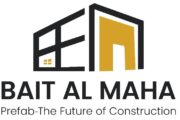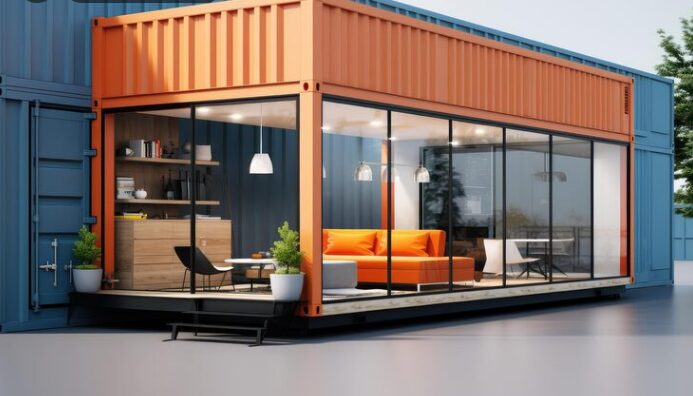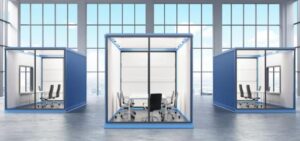Container offices have revolutionized workspace solutions in the United Arab Emirates (UAE), a nation celebrated for its architectural innovation, rapid infrastructure development, and commitment to sustainability. These structures, crafted from repurposed shipping containers, offer a versatile, portable, and eco-friendly alternative to traditional office buildings. In a country where dynamic construction projects, bustling logistics hubs, and a focus on green initiatives shape the economic landscape, Container Office Solution provides a practical and innovative solution for businesses, entrepreneurs, and public sector entities.
Container Office Solution are not merely a trend but a response to the UAE’s evolving needs. The nation’s construction boom, driven by projects such as Dubai’s Expo City and Abu Dhabi’s Masdar City, requires flexible workspaces that can be quickly erected and relocated as needed. Similarly, the UAE’s logistics sector, centered around major ports like Jebel Ali, relies on portable solutions to support operations in dynamic environments. By repurposing shipping containers, these offices reduce waste and align with the UAE’s sustainability goals, such as those outlined in the UAE Vision 2021 and Dubai Clean Energy Strategy 2050. This guide will explore how container offices meet these demands while addressing challenges like climate resilience, regulatory compliance, and cultural integration.
Understanding Container Offices
Container offices are workspaces created by converting shipping containers—robust steel structures designed for global cargo transport—into functional office environments. These containers, typically 20ft or 40ft in length, are transformed through modifications like insulation, window installation, and utility integration to create comfortable, professional spaces. In the UAE, where extreme temperatures and rapid development define the landscape, container offices provide a durable, portable, and sustainable solution for various workspace needs.
What Are Container Offices?
The concept of Container Office Solution originates from the global shipping industry, where standardized containers (ISO-compliant) are used for their strength, stackability, and portability. These containers, made of corten steel, are designed to withstand harsh marine environments, making them ideal for repurposing into durable workspaces. In the UAE, the conversion process involves reinforcing the container’s structure, adding insulation to combat heat, and installing features like air conditioning, electrical systems, and plumbing. The result is a modular, mobile office that can be deployed in days, compared to the months it would take for traditional construction.
The transformation process begins with selecting a container, which may be new or used, depending on the project’s requirements. The container is cleaned, repaired, and modified to include openings for doors and windows, which are sealed to maintain structural integrity. Insulation, often polyurethane foam or mineral wool, is applied to walls, floors, and ceilings to regulate temperature in the UAE’s scorching climate, where summer temperatures can exceed 45°C. Electrical wiring, lighting, and HVAC systems are integrated to ensure functionality, while interior finishes like drywall, flooring, and paint create a professional aesthetic. Exterior coatings protect against corrosion, particularly in coastal areas with high humidity and exposure to salt.
Container offices can be standalone units or combined to form larger, more complex structures. For example, multiple containers can be stacked vertically or arranged horizontally to create multi-room offices, complete with meeting spaces, reception areas, and amenities like bathrooms or kitchenettes. This modularity allows for scalability, making Container Office Solution suitable for small startups, large construction projects, or temporary event spaces. In the UAE, where flexibility is key in fast-paced industries, this adaptability is a significant advantage.
Benefits of Container Offices
Container offices offer numerous benefits, particularly in the UAE’s dynamic environment. Their durability, derived from corten steel construction, ensures resistance to extreme weather, including sandstorms and high humidity. This makes them ideal for both urban and remote settings, from Dubai’s bustling construction sites to the desert outskirts of Al Ain. Their portability allows for easy relocation, enabling businesses to move offices as project locations change, a critical feature for the UAE’s infrastructure-heavy economy.
The speed of deployment is another advantage. Unlike traditional buildings, which require extensive planning and construction, container offices can be modified and installed in weeks. This rapid setup is invaluable for time-sensitive projects, such as temporary offices for infrastructure developments or event-based workspaces. The modular design also allows for customization, enabling users to tailor layouts, features, and aesthetics to specific needs, whether for a minimalist construction site office or a stylish retail space.
Sustainability is a core benefit, aligning with the UAE’s environmental goals. Repurposing shipping containers reduces the need for new construction materials, minimizing waste and carbon emissions. Energy-efficient features, such as solar panels or LED lighting, further reduce environmental impact. In a country committed to green building practices, Container Office Solution offer a practical way to achieve sustainability without sacrificing functionality.
Applications in the UAE
Container offices serve a wide range of applications in the UAE, reflecting the nation’s diverse economic and social landscape. In construction, they function as site offices, providing project managers with on-site workspaces equipped with desks, internet, and climate control. These offices can be relocated as projects progress, ensuring operational continuity. For example, a container office might serve as a command center for a skyscraper project in Dubai, then be moved to a new site in Sharjah.
In retail and hospitality, Container Office Solution are transformed into pop-up shops, cafes, or exhibition spaces. Their unique aesthetic—often combining industrial steel with modern finishes—attracts customers in urban markets like Dubai’s Al Quoz or Abu Dhabi’s Corniche. These setups can be customized with branding, large windows, or outdoor seating to create inviting environments. Their mobility makes them ideal for seasonal markets or festivals, such as those during Dubai Shopping Festival.
Healthcare and education also benefit from Container Office Solution. Mobile clinics, fitted with medical equipment and sanitation facilities, deliver healthcare to remote communities, addressing gaps in access. Temporary classrooms, equipped with desks, whiteboards, and Wi-Fi, support educational initiatives in underserved areas or during school renovations. These applications highlight the versatility of container offices in meeting the UAE’s diverse needs.
Market Overview of Container Offices in the UAE
The UAE’s market for Container Office Solution is driven by its role as a global trade and logistics hub, coupled with its ambitious infrastructure projects and sustainability initiatives. The nation’s strategic location, with major ports like Jebel Ali and Khalifa Port, ensures a steady supply of shipping containers for conversion. The construction sector, fueled by projects like Dubai South and Abu Dhabi’s cultural districts, creates a constant demand for flexible workspaces that can be deployed rapidly and relocated as needed.
Market Drivers
The UAE’s logistics sector is a key driver, with its ports handling millions of containers annually. These containers, once retired from shipping, are ideal for conversion into offices, providing a readily available resource. The country’s role in global trade initiatives, such as China’s Belt and Road, increases the need for temporary workspaces at ports, warehouses, and logistics hubs. Container offices meet this demand by offering portable, durable solutions that can be set up near operational sites.
Infrastructure development is another major driver. The UAE’s ongoing projects—ranging from residential towers to renewable energy facilities—require on-site offices for project management, engineering, and administration. Container Office Solution provides a cost-effective alternative to permanent structures, allowing businesses to maintain operational efficiency without long-term commitments. Their ability to be customized for specific project needs, such as adding meeting rooms or storage, enhances their appeal.
Urbanization and population growth also contribute to demand. The UAE’s growing population, particularly in Dubai and Abu Dhabi, drives the need for flexible commercial spaces, such as pop-up retail or co-working hubs. Container offices, with their modular design, can be deployed in urban centers or industrial zones, catering to startups, small businesses, and event organizers. Their aesthetic versatility allows them to blend into modern cityscapes or stand out as unique structures.
Sustainability Trends
The UAE’s commitment to sustainability, as outlined in initiatives like UAE Vision 2021 and the Dubai Clean Energy Strategy 2050, shapes the container office market. Repurposing shipping containers aligns with circular economy principles, reducing the need for new materials and minimizing construction waste. This approach supports the UAE’s goal of reducing carbon emissions and promoting resource efficiency.
Energy-efficient features are increasingly integrated into Container Office Solution. Solar panels harness the UAE’s abundant sunlight to power lighting and appliances, while high-performance insulation reduces cooling demands in the hot climate. Green roofing, using plants or reflective materials, mitigates heat absorption, lowering energy consumption. These features align with the UAE’s green building standards, such as Estidama and LEED, which prioritize sustainable construction.
The government’s emphasis on sustainable urban planning encourages the adoption of container offices in eco-conscious projects. For example, developments like Masdar City in Abu Dhabi prioritize low-carbon solutions, making Container Office Solution an ideal choice for temporary or permanent workspaces. Public awareness of environmental issues also drives demand, as businesses seek to demonstrate their commitment to sustainability through eco-friendly office solutions.
Challenges
The container office market faces logistical challenges, particularly related to transportation. The UAE’s busy ports can experience congestion, delaying container availability. Road transport, particularly in urban areas like Dubai, necessitates meticulous planning to navigate traffic and ensure timely deliveries. These issues can be mitigated through the use of digital tracking systems and partnerships with experienced logistics providers.
The UAE’s extreme climate poses another challenge. Temperatures exceeding 45°C demand robust insulation and cooling systems, which must be carefully designed to maintain comfort without excessive energy use. Sandstorms and high humidity can accelerate corrosion, requiring specialized coatings and regular maintenance. These environmental factors necessitate high-quality conversions tailored to local conditions.
Regulatory compliance is a significant hurdle. Container Office Solution must adhere to UAE building codes, which regulate structural integrity, fire safety, and accessibility. Zoning laws vary by emirate, with stricter requirements in urban areas like Dubai compared to industrial zones in Sharjah. Navigating these regulations requires expertise, as non-compliance can lead to project delays or fines.
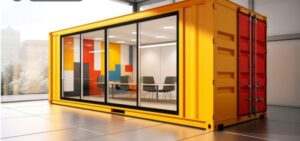
Features and Customization Options
Container offices are highly customizable, allowing users to adapt them to specific functional and aesthetic needs. Their modular nature enables a range of configurations, from basic setups to sophisticated complexes, making them suitable for diverse applications in the UAE’s varied landscape.
Standard Features
Standard Container Office Solution includes essential features to ensure functionality. Insulation, typically polyurethane foam or mineral wool, is applied to walls, floors, and ceilings to combat the UAE’s extreme heat. Double-glazed windows enhance energy efficiency while allowing natural light, reducing reliance on artificial lighting. Air conditioning systems, designed for high temperatures, maintain a comfortable indoor environment, with units sized to match the container’s dimensions.
Electrical systems are integrated to support office equipment, including outlets for computers, printers, and lighting. LED fixtures are standard for their energy efficiency and long lifespan, critical in the UAE’s sustainability-focused market. Doors, often steel or glass, provide secure access, while ventilation systems ensure air quality in enclosed spaces. These features create a functional workspace suitable for immediate use.
Flooring options, such as vinyl or laminate, provide durability and a professional appearance. Interior walls are often finished with drywall or paneling, concealing insulation and wiring for a polished look. Exterior coatings, like anti-corrosion paint, protect against environmental wear, while aesthetic finishes—such as wood cladding or vibrant colors—enhance visual appeal.
Advanced Customizations
Advanced customizations transform container offices into fully equipped workspaces. Partitions, made of lightweight materials like gypsum board, create separate rooms for meetings, private offices, or storage. Built-in furniture, such as desks, shelves, or cabinets, optimizes space in compact containers, ensuring efficient use of the 20ft or 40ft footprint.
Kitchenettes, equipped with sinks, countertops, and appliances like microwaves or refrigerators, cater to long-term use, such as in remote construction sites. Bathrooms, including toilets, showers, and washbasins, provide self-contained solutions for isolated locations, with water tanks or sewage connections for functionality. These amenities make container offices viable for extended projects or permanent installations.
Aesthetic customizations allow for branding or cultural alignment. For example, containers can be painted with company logos or designed with Arabic-inspired patterns, such as geometric motifs or calligraphy, to reflect UAE’s cultural heritage. Large windows or glass doors create an open, modern feel, while exterior cladding, like aluminum or wood, enhances integration into urban environments.
Eco-Friendly Options
Sustainability is a priority in the UAE, and Container Office Solution can be customized with eco-friendly features. Solar panels, mounted on the roof, harness abundant sunlight to power lighting, HVAC, or electronics, reducing reliance on grid electricity. Energy-efficient windows, with low-emissivity coatings, minimize heat gain, while smart thermostats optimize cooling for energy savings.
Green roofing, using plants or reflective materials, reduces heat absorption and improves insulation, lowering cooling costs. Water recycling systems, such as greywater treatment for flushing toilets, conserve resources in water-scarce regions. Low-VOC paints and sustainable materials, like recycled insulation or bamboo flooring, further reduce environmental impact, aligning with the UAE’s green building goals.
Technology Integration
Technology enhances Container Office Solution functionality, particularly in the UAE’s innovation-driven market. Smart lighting systems adjust brightness based on occupancy or time of day, reducing energy use. IoT sensors monitor temperature, humidity, and air quality, providing data to maintain optimal conditions and alert users to maintenance needs, such as HVAC servicing.
Security features, such as biometric locks or CCTV cameras, protect sensitive equipment or documents, critical for offices in high-traffic areas. Smart windows, which tint automatically to reduce glare, improve comfort in the UAE’s intense sunlight. These technological integrations make Container Office Solutions suitable for high-tech industries, such as IT or logistics, where efficiency and security are paramount.
Choosing the Right Container Office Supplier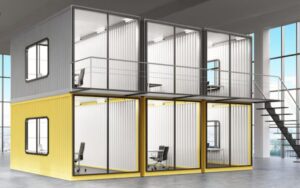
Selecting a supplier for Container Office Solution in the UAE requires careful consideration to ensure the solution meets specific needs. Suppliers should have expertise in container conversions, particularly in addressing the UAE’s climate and regulatory requirements. Their ability to deliver customized, high-quality units on time is critical for project success.
Factors to Consider
Key factors include the supplier’s experience with UAE-specific conversions, such as insulation for extreme heat or compliance with local building codes. Suppliers should offer a range of options, from basic units for temporary use to fully customized complexes with amenities like bathrooms or smart technology. Their understanding of the UAE’s diverse applications—construction, retail, healthcare—ensures they can tailor solutions to specific industries.
Reliability and reputation are essential. Suppliers should provide detailed project timelines, transparent communication, and a portfolio of successful installations. Their ability to handle logistics, such as transporting containers through busy ports like Jebel Ali, is crucial for timely delivery. After-sales support, including maintenance or modification services, ensures long-term functionality.
Sustainability is another consideration, as the UAE prioritizes eco-friendly solutions. Suppliers should offer options like solar panels, energy-efficient insulation, or recycled materials to align with green building standards. Their knowledge of local regulations, such as Dubai Municipality’s building codes, ensures compliance and avoids delays.
Questions to Ask Suppliers
When evaluating suppliers, ask about their conversion process, including materials used, insulation methods, and quality control measures. Inquire about their experience with UAE-specific challenges, such as heat resistance or sandstorm durability. Request details on customization options, such as adding partitions, bathrooms, or smart features, to ensure they meet project needs.
Inquire about delivery timelines and logistics, especially how they manage port congestion or urban traffic. Clarify their approach to regulatory compliance, including obtaining necessary permits and adhering to relevant building codes. Inquire about after-sales services, such as maintenance contracts or warranty terms, to ensure long-term support. These questions help assess a supplier’s capability and reliability.
Rental vs. Purchase
Renting a Container Office Solution is ideal for short-term projects, such as construction sites or event spaces, offering flexibility and minimal upfront investment. Rental agreements typically include delivery, installation, and maintenance, reducing operational burdens. However, renting may limit customization options and involve ongoing costs, making it less suitable for permanent needs.
Purchasing is better for long-term or permanent installations, allowing for extensive customization and ownership benefits. Buyers can design units to exact specifications, integrating features like kitchenettes or advanced technology. While purchasing requires a higher initial investment, it eliminates recurring rental fees and allows for reuse across multiple projects, enhancing cost-effectiveness.
The choice depends on project duration, budget, and customization needs. Short-term projects benefit from renting’s flexibility, while long-term needs favor purchasing’s control and savings. Businesses should evaluate their operational goals, site requirements, and relocation plans to make an informed decision.
Technical Specifications of Container Offices
Container offices are built from standardized shipping containers, designed to meet rigorous technical specifications for durability, functionality, and compliance. Understanding these specifications is essential for ensuring they meet the UAE’s environmental and regulatory demands.
Container Sizes
Standard containers come in 20ft (6m) and 40ft (12m) lengths, with widths of 8ft (2.4m) and heights of 8.5ft (2.6m) or 9.5ft (2.9m) for high cube units. These sizes provide a compact footprint, ideal for small offices or modular complexes. For example, a 20ft container offers approximately 160 square feet of usable space, while a 40ft unit provides 320 square feet, suitable for larger teams or multi-room setups.
Custom sizes are possible through cutting and welding, though this increases complexity and cost. For instance, two 20ft containers can be joined to create a wider office, or a 40ft container can be divided into smaller rooms. High cube containers offer extra headroom, improving comfort and allowing for features like suspended ceilings or overhead storage. These options provide flexibility for diverse applications, from single offices to expansive complexes.
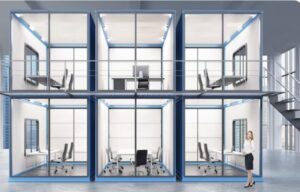
Materials and Construction
The primary material is corten steel, a weather-resistant alloy designed for marine environments. Its strength ensures structural integrity, while its corrosion resistance protects against the UAE’s humid coastal conditions. Containers are reinforced during conversion to support added features, such as windows or doors, without compromising stability.
Insulation is critical for the UAE’s climate. Polyurethane foam, sprayed onto interior surfaces, provides high thermal resistance, reducing heat transfer. Mineral wool or polystyrene panels are alternatives, offering fire resistance and acoustic insulation. Flooring, often plywood or vinyl, is layered over insulation to create a durable, comfortable surface, while exterior coatings, like epoxy or polyurethane paint, prevent rust and UV damage.
Windows and doors are made of tempered glass or steel, sealed to maintain insulation and security. Electrical systems, including wiring and outlets, are installed to meet UAE standards, with conduits hidden behind interior finishes. HVAC units, sized for the container’s volume, ensure cooling in extreme heat, while ventilation systems maintain air quality. These materials and construction techniques create a robust, functional workspace.
Compliance Standards
Container Office Solution must meet international and UAE-specific standards. ISO 668 and ISO 1496 ensure containers are structurally sound for transport and modification, specifying requirements for strength, rigidity, and weatherproofing. The Container Safety Convention (CSC) certification verifies containers are safe for reuse, with inspections checking for structural damage or corrosion.
UAE building codes, enforced by municipalities, regulate electrical systems, fire safety, and accessibility. For example, Dubai Municipality requires fire-resistant materials and emergency exits, while Abu Dhabi emphasizes energy efficiency. Compliance with these standards ensures safety and legality, with documentation submitted during the permitting process. Adhering to these regulations is critical for successful deployment in the UAE.
Regulatory Framework for Container Offices in the UAE
The UAE’s regulatory framework for container offices is shaped by its commitment to safety, sustainability, and urban planning. Compliance with these regulations ensures that container offices are safe, functional, and aligned with national goals.
UAE Building Codes
UAE building codes, administered by entities like Dubai Municipality and Abu Dhabi’s Department of Municipalities and Transport, set standards for structural integrity, fire safety, and environmental performance. Container Office Solution must withstand local conditions, including temperatures up to 50°C and occasional sandstorms. Structural reinforcements, such as steel bracing, ensure stability, while fire-resistant materials, like gypsum board, meet safety requirements.
Electrical systems must comply with UAE standards, such as those set by the Dubai Electricity and Water Authority (DEWA). This includes proper grounding, circuit breakers, and energy-efficient wiring. HVAC systems must meet cooling capacity requirements, with regular maintenance to prevent failures in extreme heat. Accessibility standards, such as ramps or wide doorways, ensure compliance for users with disabilities.
Environmental regulations emphasize energy efficiency and waste reduction. Container offices must incorporate sustainable features, like insulation or LED lighting, to meet green building standards. Regular inspections during construction and installation verify compliance, with non-compliant units facing fines or delays. Understanding these codes is essential for successful deployment.
Zoning Regulations
Zoning laws vary by emirate, influencing where container offices can be placed. In urban areas like Dubai, strict guidelines govern the aesthetic integration of container offices, requiring them to blend seamlessly with modern architecture. For example, containers in Dubai’s Business Bay may need sleek finishes or cladding to match surrounding buildings. Industrial zones, such as Sharjah’s Sajja or Ras Al Khaimah’s industrial parks, offer more flexibility, allowing raw steel exteriors.
Temporary installations, common in construction or event settings, face fewer zoning restrictions but still require permits. Permanent installations must align with land use plans, ensuring they don’t disrupt urban development. For example, container offices in Abu Dhabi’s cultural districts must complement heritage-focused aesthetics. Consulting with municipal authorities early in the planning process ensures compliance and avoids zoning conflicts.
Permitting Process
Obtaining permits for container offices involves submitting detailed plans to municipal authorities, including structural designs, electrical layouts, and environmental impact assessments. In Dubai, the permitting process may take 2-4 weeks, depending on project complexity, while Abu Dhabi’s process can be longer for permanent installations. Plans must demonstrate compliance with building codes, zoning laws, and sustainability standards.
Temporary permits, for projects like construction site offices, are simpler, requiring basic documentation and site plans. Permanent permits demand comprehensive assessments, including seismic evaluations (though the UAE has low seismic risk) and energy efficiency reports. Engaging a consultant familiar with UAE regulations can streamline the process, ensuring all requirements are met. Regular inspections during installation verify adherence to approved plans.
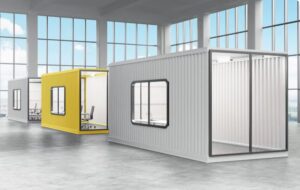
Cost Analysis of Container Offices
The cost of container offices depends on factors like size, customization, and features, though they remain more affordable than traditional construction due to their use of pre-existing containers. Understanding these cost factors helps businesses plan effective workspace solutions in the UAE.
Purchase Costs
Purchasing a container office involves the cost of the container itself, conversion materials, and labor. Basic conversions, including insulation, windows, and air conditioning, are cost-effective due to the container’s pre-built structure. Advanced features, like bathrooms, kitchenettes, or smart technology, increase costs but remain competitive compared to brick-and-mortar buildings. The UAE’s access to shipping containers through major ports ensures availability, keeping base costs manageable.
Additional costs include site preparation, such as laying a concrete foundation or connecting utilities, and transportation, which varies based on distance and logistics challenges. Customizations, like exterior cladding or solar panels, add to the investment but enhance functionality and sustainability. Businesses should request detailed quotes from suppliers to understand the full scope of costs, ensuring alignment with project budgets.
Rental Costs
Renting container offices is a flexible option for temporary needs, such as construction projects or events. Rental agreements typically cover delivery, installation, and maintenance, reducing operational burdens. The cost depends on the rental duration, unit size, and customization level, with basic units being more affordable than fully equipped ones.
Rental terms vary, with short-term leases (e.g., 3-6 months) offering flexibility and long-term leases providing cost savings. Businesses should review contracts for maintenance responsibilities, relocation options, and termination clauses. Renting is ideal for projects with uncertain timelines, as it avoids the commitment of purchasing while providing immediate workspace solutions.
Cost-Benefit Analysis
Container offices offer significant cost advantages over traditional buildings. Their rapid construction reduces labor and time costs, critical in the UAE’s fast-paced environment. Portability allows for reuse across multiple projects, maximizing investment value. Energy-efficient features, like solar panels or insulation, lower operational costs, particularly for cooling in the UAE’s climate.
Compared to traditional offices, container offices require less material and produce less waste, aligning with sustainability goals and reducing environmental costs. Their durability ensures a long lifespan, minimizing replacement or repair expenses. Businesses should weigh these benefits against project needs, such as duration and customization, to determine the most cost-effective approach.
Design Trends in Container Offices
Container office design in the UAE blends functionality with aesthetic innovation, reflecting the nation’s modern and cultural sensibilities. These trends cater to diverse applications, from industrial site offices to stylish urban workspaces.
Architectural Styles
Minimalist designs are popular for their clean lines and neutral colors, creating versatile workspaces that fit urban or industrial settings. Industrial designs embrace the container’s raw steel exterior, appealing to construction sites or creative industries. Modern designs incorporate sleek finishes, large glass windows, and vibrant colors, aligning with Dubai’s futuristic skyline or Abu Dhabi’s cultural districts.
Hybrid designs combine containers with traditional materials, such as wood or concrete, to create unique aesthetics. For example, a container office might feature a steel exterior with wooden cladding, blending industrial and natural elements. These styles allow businesses to tailor container offices to their brand or project requirements, ensuring visual appeal and functionality.
Interior Design
Interior design focuses on maximizing space and comfort in compact containers. Ergonomic furniture, like adjustable desks and chairs, enhances productivity, while built-in storage, such as shelves or cabinets, optimizes space. Natural light, provided by large windows or skylights, improves employee well-being, critical in the UAE’s intense sunlight.
Lighting is a key element, with LED fixtures offering energy-efficient illumination. Task lighting, such as desk lamps, supports focused work, while ambient lighting creates a welcoming atmosphere. Flooring options, like vinyl or carpet tiles, provide durability and comfort, while acoustic panels reduce noise in open-plan layouts, ensuring a productive environment.
Technology Integration
Technology enhances container office design, particularly in the UAE’s innovation-driven market. Smart lighting systems adjust brightness based on occupancy or time, reducing energy use. IoT sensors monitor environmental conditions, such as temperature or air quality, ensuring comfort and efficiency. Smart windows, which tint to reduce glare, improve comfort in bright sunlight.
Security features, like biometric locks or motion-sensor cameras, protect sensitive assets, critical for offices in high-traffic areas. Integrated Wi-Fi and data cabling support connectivity for modern workflows, such as remote collaboration or cloud-based systems. These technological trends make container offices suitable for tech-savvy industries, aligning with the UAE’s digital transformation goals.
Sustainability and Environmental Impact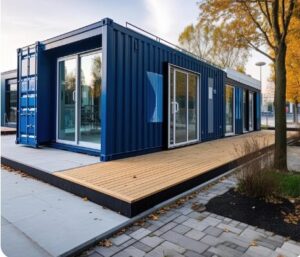
Container offices are inherently sustainable, as they repurpose existing shipping containers, reducing the need for new construction materials. This aligns with the UAE’s commitment to a circular economy, which emphasizes resource efficiency and waste reduction.
Eco-Friendly Materials
Repurposing containers minimizes material waste, as each unit is reused rather than discarded. Insulation materials, like recycled polyurethane or mineral wool, enhance energy efficiency while reducing environmental impact. Flooring options, such as bamboo or recycled vinyl, provide sustainable alternatives to traditional materials, while low-VOC paints improve indoor air quality.
Exterior coatings, like eco-friendly polyurethane, protect against corrosion without harmful chemicals. Green roofing, using plants or reflective materials, reduces heat absorption and supports biodiversity. These materials ensure container offices meet the UAE’s sustainability standards, contributing to greener infrastructure.
Energy Efficiency
Energy efficiency is critical in the UAE’s hot climate, where cooling demands are high. High-performance insulation, such as spray foam, minimizes heat transfer, reducing HVAC energy use. Double-glazed windows with low-emissivity coatings prevent heat gain, while smart thermostats optimize cooling based on occupancy or weather conditions.
Solar panels are increasingly common, harnessing the UAE’s abundant sunlight to power lighting, appliances, or HVAC systems. LED lighting, with its low energy consumption and long lifespan, is standard in container offices. These features lower operational costs and align with the UAE’s goal of increasing renewable energy use, as outlined in the Dubai Clean Energy Strategy 2050.
UAE Green Building Goals
The UAE’s sustainability initiatives, such as UAE Vision 2021 and Abu Dhabi’s Estidama program, prioritize low-carbon infrastructure. Container offices support these goals by reducing construction waste and incorporating energy-efficient technologies. Certifications like LEED or Estidama are achievable through sustainable design, such as solar integration or water recycling systems.
Public awareness of environmental issues drives demand for green workspaces. Container offices, with their eco-friendly features, appeal to businesses seeking to demonstrate corporate social responsibility. Their alignment with national sustainability goals positions them as a key component of the UAE’s green future.
Container Office Applications Across Industries
Container offices serve a wide range of industries in the UAE, reflecting their adaptability and versatility. Their modular design and portability make them suitable for both temporary and permanent applications.
Construction
In construction, container offices function as site offices, providing project managers with on-site workspaces. These units are equipped with desks, internet, and climate control, creating a professional environment for planning and coordination. Their portability allows relocation as projects progress, ensuring operational continuity across sites in Dubai, Abu Dhabi, or Sharjah.
Container offices can be customized with meeting rooms, storage for blueprints, or secure lockers for equipment. Their durability withstands construction site conditions, such as dust or heavy machinery vibrations. These features make them indispensable for the UAE’s infrastructure projects, from residential towers to transportation networks.
Retail and Hospitality
In retail and hospitality, container offices are transformed into pop-up shops, cafes, or event spaces. Their unique aesthetic, combining steel with modern finishes, attracts customers in urban markets like Dubai’s Alserkal Avenue or Abu Dhabi’s Yas Island. Customizations, such as large windows, outdoor seating, or branded exteriors, create inviting environments.
These setups are ideal for seasonal markets, festivals, or temporary retail activations, such as those during Ramadan or Dubai Design Week. Their mobility allows businesses to move to high-traffic locations, maximizing visibility. The modular design supports creative configurations, like multi-container complexes for larger events or retail hubs.
Healthcare and Education
Container offices serve as mobile clinics in healthcare, delivering services to remote communities or disaster-affected areas. Equipped with medical beds, diagnostic tools, and sanitation facilities, these units address healthcare access challenges. Their portability enables rapid deployment, critical for emergency response or outreach programs.
In education, container offices function as temporary classrooms or training centers. Fitted with desks, whiteboards, and Wi-Fi, they support educational initiatives in underserved areas or during school renovations. Their adaptability ensures they meet diverse needs, from primary education to vocational training, supporting the UAE’s educational goals.
Logistics and Installation of Container Offices
Deploying container offices in the UAE involves careful logistical planning and installation processes to ensure efficiency and compliance.
Transportation
Transporting container offices requires navigating the UAE’s busy ports and roads. Containers are moved by flatbed trucks, with routes planned to avoid urban congestion in cities like Dubai. Port operations, such as those at Jebel Ali, demand coordination to secure containers and arrange timely delivery.
Logistical challenges, like port congestion or road restrictions, can cause delays. Digital tracking systems monitor container movements, providing real-time updates to streamline delivery. Partnerships with experienced logistics providers ensure containers reach sites efficiently, minimizing disruptions to project timelines.
Site Preparation
Site preparation is critical for stability and functionality. A level foundation, such as concrete slabs or gravel beds, prevents settling or shifting. Utility connections, including electricity, water, and sewage, must be planned in advance, with temporary solutions like generators or water tanks used in remote areas.
Site assessments evaluate soil conditions, drainage, and accessibility to ensure suitability. In urban areas, space constraints may require compact designs or stacked configurations. Proper preparation, guided by engineers or consultants, ensures compliance with safety and regulatory standards.
Installation Process
Installation is faster than traditional construction, often completed in days or weeks. Cranes or forklifts position containers, which are secured to the foundation using bolts or anchors. Utility connections are installed, followed by interior finishing, such as flooring, lighting, and furniture.
Inspections during installation verify structural integrity, electrical safety, and compliance with building codes. In the UAE, where heat and humidity are concerns, additional checks ensure insulation and HVAC systems perform effectively. This streamlined process enables rapid deployment, critical for time-sensitive projects.

Technology in Container Offices
Technology enhances the functionality and efficiency of container offices, aligning with the UAE’s innovation-driven economy.
Smart Office Features
Smart office features include automated lighting and climate control systems, which adjust based on occupancy or environmental conditions. For example, motion-sensor lighting reduces energy use in unoccupied areas, while smart thermostats optimize cooling for the UAE’s heat. These systems improve comfort and lower operational costs.
IoT devices monitor temperature, humidity, and air quality, providing data to maintain optimal conditions. For instance, sensors can alert users to HVAC malfunctions, preventing downtime. These features make container offices suitable for high-tech industries, such as IT or logistics, where efficiency is critical.
Container Monitoring
Container monitoring systems track structural integrity and environmental performance. Sensors detect corrosion, structural stress, or insulation degradation, enabling proactive maintenance. In the UAE’s humid coastal areas, these systems are vital for preventing rust and extending lifespan.
Real-time data from monitoring systems supports predictive maintenance, identifying issues before they escalate. For example, sensors can detect leaks or electrical faults, prompting timely repairs. These systems enhance reliability, ensuring container offices remain functional in challenging conditions.
AI and Automation
AI and automation are emerging trends, with applications like predictive maintenance algorithms that anticipate equipment failures. Automated HVAC systems adjust cooling based on occupancy patterns, reducing energy waste. AI-driven analytics optimize space usage, recommending layouts for maximum efficiency.
Voice-activated assistants or remote control systems enhance user experience, allowing employees to manage lighting or security via smartphones. These technologies position container offices as modern, high-tech workspaces, appealing to businesses in the UAE’s innovation hubs like Dubai Internet City.
Cultural Relevance of Container Offices in the UAE
Container offices resonate with the UAE’s cultural blend of tradition and modernity, making them a relevant solution for diverse communities.
Alignment with UAE Culture
The UAE’s history of nomadic lifestyles, where mobility and adaptability were key, parallels the portability of container offices. These structures can be deployed in remote desert areas or urban centers, reflecting the nation’s ability to balance tradition with progress. For example, a container office in the Liwa Desert can serve as a community hub, mirroring the mobility of traditional Bedouin camps.
The UAE’s entrepreneurial spirit also aligns with container offices, which support startups and small businesses with affordable, flexible workspaces. Their modular design allows for rapid scaling, catering to the nation’s dynamic business landscape. This adaptability makes them a cultural fit for a country known for innovation and ambition.
Aesthetic Preferences
Aesthetic preferences in the UAE blend modern minimalism with traditional elements. Container offices can be customized with Arabic-inspired designs, such as geometric patterns or calligraphy, to reflect cultural heritage. For example, a container office in Abu Dhabi’s Al Ain might feature motifs inspired by local architecture, enhancing community acceptance.
Modern designs, with sleek glass windows or vibrant colors, appeal to urban areas like Dubai’s Downtown. Industrial aesthetics, showcasing raw steel, resonate with creative industries or construction sites. These options ensure container offices integrate seamlessly into the UAE’s diverse aesthetic landscape.
Community Impact
Container offices support community development by providing affordable workspaces for small businesses, fostering entrepreneurship. In rural areas, they serve as educational or healthcare facilities, addressing social needs. For example, a container office in Fujairah could function as a training center, supporting skill development for local youth.
Their sustainability aligns with the UAE’s cultural emphasis on environmental stewardship, rooted in Islamic principles of resource conservation. By repurposing containers and incorporating green features, these offices contribute to community well-being, enhancing their cultural and social relevance.
Financing and Investment Options
Financing container offices in the UAE involves various options, from loans to government incentives, supporting their adoption across industries.
Bank Loans and Leasing
Bank loans for construction or business expansion can cover container office purchases, with terms tailored to project needs. Leasing agreements offer flexibility for temporary projects, allowing businesses to rent units without long-term commitments. These options provide financial flexibility, accommodating diverse budgets.
Leasing contracts typically include maintenance and delivery, reducing operational costs. Businesses should review terms for customization options, relocation policies, and termination clauses. Loans, while requiring repayment, offer ownership benefits, allowing for extensive modifications and long-term use.
Government Incentives
The UAE offers incentives for sustainable construction, such as grants or tax benefits, which apply to eco-friendly container offices. Programs like Abu Dhabi’s Estidama initiative encourage green building practices, providing financial support for projects with solar panels or energy-efficient designs. Businesses should research these opportunities through government portals or consultants.
Incentives align with the UAE’s sustainability goals, rewarding businesses that reduce environmental impact. Container offices, with their repurposed materials and green features, qualify for such programs, making them an attractive investment. Proper documentation, such as energy efficiency reports, is required to access these benefits.
ROI Analysis
The return on investment for container offices is driven by their low construction costs and durability. Rapid deployment reduces labor expenses, while portability allows reuse across projects, maximizing value. Energy-efficient features, like solar panels, lower operational costs, particularly for cooling.
Compared to traditional offices, container offices offer long-term savings through reduced material and maintenance costs. Their adaptability ensures they meet evolving needs, such as expanding office space or relocating to new sites. Businesses should evaluate these factors to assess the financial benefits of container offices.
Maintenance and Durability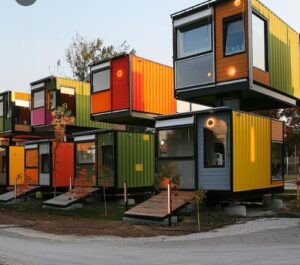
Maintaining container offices ensures their longevity and functionality, particularly in the UAE’s challenging climate.
Routine Maintenance
Routine maintenance includes cleaning exterior surfaces to prevent corrosion, especially in coastal areas with high humidity. Regular inspections check for structural damage, such as dents or rust, while interior maintenance ensures HVAC, electrical, and plumbing systems function properly. Cleaning windows and ventilation systems maintains air quality and comfort.
Seasonal maintenance, such as resealing joints before the rainy season, prevents leaks. HVAC filters should be replaced regularly to ensure efficient cooling, critical in the UAE’s heat. These tasks, performed quarterly or biannually, extend the container’s lifespan and maintain a professional appearance.
Durability Factors
Container offices are highly durable, with corten steel construction designed for marine environments. This material resists corrosion, sandstorms, and UV exposure, ensuring a lifespan of 20-30 years with proper care. Insulation and coatings enhance durability by protecting against heat and humidity.
Structural reinforcements, such as steel bracing, maintain integrity during modifications or stacking. Regular maintenance, like repainting or resealing, prevents environmental wear. These factors ensure container offices remain robust in the UAE’s harsh conditions, providing reliable workspaces.
Repair Services
Repairs address issues like corrosion, insulation damage, or electrical faults. Welding restores structural integrity, while repainting protects against rust. Insulation repairs, such as patching foam, maintain thermal efficiency, and HVAC servicing ensures consistent cooling. These services, offered by specialized providers, keep container offices functional.
In the UAE, where rapid response is critical, repair services should be available on short notice. Businesses should maintain relationships with reliable providers to address issues promptly, minimizing downtime. Proactive repairs, guided by monitoring systems, enhance durability and performance.
Case Studies of Successful Container Office Projects
Container offices have been successfully deployed across the UAE, showcasing their versatility and impact.
Urban Retail Complex
In a bustling Dubai district, a retail complex used multiple container offices to create pop-up shops and cafes. The containers were arranged in a U-shaped layout, with large windows and vibrant exteriors to attract customers. Customizations included outdoor seating, branded signage, and energy-efficient lighting, creating a vibrant market atmosphere.
The project leveraged the containers’ portability, allowing relocation to a new site after the lease ended. Its success demonstrated the appeal of container offices for temporary retail, offering businesses a cost-effective way to test markets. The design, blending industrial and modern elements, aligned with Dubai’s urban aesthetic.
Construction Site Office
On a major Abu Dhabi construction site, container offices served as a project management hub. The units, equipped with meeting rooms, internet, and climate control, provided a professional workspace for engineers and managers. Their durability withstood dust and machinery vibrations, while portability allowed relocation as the project progressed.
Customizations included secure storage for blueprints and ergonomic furniture for long work hours. The rapid setup ensured the project stayed on schedule, highlighting the efficiency of container offices in construction. The units’ sustainability, with solar panels and insulation, aligned with Abu Dhabi’s green goals.
Rural Healthcare Facility
In a remote Fujairah community, a container office was converted into a mobile clinic. Equipped with medical beds, diagnostic tools, and sanitation facilities, it delivered healthcare to underserved residents. The unit’s portability enabled deployment in multiple villages, addressing access gaps.
The clinic featured solar panels for power and water recycling for sustainability, critical in resource-scarce areas. Its success showcased the adaptability of container offices for social impact, supporting the UAE’s healthcare outreach goals. The project’s modular design allowed for future expansion, demonstrating long-term potential.
Future Trends and Innovations
The future of container offices in the UAE is shaped by technological advancements, sustainability goals, and emerging applications.
Technological Advancements
Blockchain technology could streamline container logistics, improving tracking and supply chain efficiency. IoT integration will enhance smart office capabilities, with sensors optimizing energy use and monitoring structural health. For example, real-time data could adjust cooling based on weather forecasts, reducing costs.
Augmented reality (AR) could aid design and installation, allowing architects to visualize layouts before construction. Drones may streamline transportation, delivering containers to remote sites with precision. These technologies align with the UAE’s innovation hubs, like Dubai Future Foundation, positioning container offices as high-tech solutions.
Sustainability Goals
Sustainability will drive innovation, with zero-emission containers incorporating advanced green materials, like bio-based insulation or recyclable composites. Green certifications, such as LEED or Estidama, will become standard, ensuring compliance with the UAE’s environmental goals. Water harvesting systems could support off-grid operations in desert areas.
Public-private partnerships may fund sustainable container office projects, supporting initiatives like Abu Dhabi’s Sustainability Week. These efforts will reduce the environmental footprint of workspaces, aligning with the UAE’s vision for a carbon-neutral future by 2050. Container offices will play a key role in this transition.
Emerging Applications
Container offices will support emerging needs, such as remote work hubs for the UAE’s growing freelance and startup communities. Co-working spaces, built from stacked containers, could offer affordable, flexible offices in Dubai’s DIFC or Abu Dhabi’s Hub71. Pop-up event spaces, like art galleries or exhibition halls, will leverage their modularity for creative deployments.
Disaster response applications, such as mobile command centers or relief offices, will grow, with containers providing rapid solutions in emergencies. These trends highlight the versatility of container offices, ensuring their relevance in the UAE’s evolving landscape.
Challenges and Solutions in the Container Office Market
The container office market faces challenges, but proactive solutions ensure successful deployment.
Logistical Challenges
Port congestion at major hubs like Jebel Ali can delay container availability. Digital tracking systems, using GPS or blockchain, provide real-time updates, streamlining logistics. Partnerships with experienced transport providers ensure timely delivery, while pre-ordering containers mitigates supply chain disruptions.
Urban traffic, particularly in Dubai, complicates transportation. Route planning, using traffic data and off-peak schedules, minimizes delays. Modular designs, allowing containers to be shipped in parts, ease transport to constrained sites, ensuring projects stay on track.
Regulatory Hurdles
Navigating UAE building codes and zoning laws requires expertise. Engaging consultants familiar with municipal regulations streamlines permitting, ensuring compliance with structural, fire, and environmental standards. Pre-designed container plans, aligned with local codes, expedite approvals.
Public awareness of regulations is critical, as non-compliance can lead to fines or project halts. Workshops or online resources, provided by industry associations, educate businesses on requirements. These solutions ensure container offices meet legal standards, avoiding costly delays.
Solutions
Technological solutions, like IoT monitoring, address logistical and maintenance challenges by providing real-time data on container conditions. Partnerships with local authorities streamline permitting, while sustainable design options ensure compliance with green building standards. These proactive measures enhance the feasibility of container offices in the UAE.
Training programs for installers and maintenance crews improve project outcomes, ensuring high-quality conversions and timely repairs. Collaboration with sustainability experts aligns container offices with national goals, enhancing their appeal. These solutions address market challenges, ensuring successful adoption.
Container Offices vs. Traditional Offices
Comparing container offices to traditional offices highlights their unique advantages in the UAE’s context.
Cost Comparison
Container offices are more cost-effective due to their use of pre-existing containers, reducing material and labor costs. Traditional offices require extensive construction, increasing expenses and timelines. Container Office Solution rapid deployment, often completed in weeks, minimizes downtime, which is critical in the UAE’s fast-paced market.
Operational costs are lower for container offices, as energy-efficient features such as insulation and solar panels reduce utility expenses. Traditional offices, with larger footprints, often have higher cooling and maintenance costs. These savings make Container Office Solution an economical choice for businesses.
Flexibility and Scalability
Container offices offer unmatched flexibility, as they can be relocated or reconfigured with minimal effort. Traditional offices, built with fixed materials like concrete, lack this adaptability. Containers can be stacked or combined to create larger complexes, scaling with business needs.
In the UAE, where projects often shift locations, such as from Dubai to Sharjah, portability is a key advantage. Traditional offices often require demolition or new construction for relocation, which increases costs and time. The modularity of container offices ensures they meet evolving demands efficiently.
Environmental Impact
Container offices have a smaller environmental footprint, as repurposing containers reduces material waste. Energy-efficient features, like LED lighting or green roofing, lower carbon emissions, aligning with the UAE’s sustainability goals. Traditional offices, with resource-intensive construction, have higher environmental impacts.
The UAE’s focus on green building, as seen in initiatives like Masdar City, favors container offices’ sustainable design. Their ability to incorporate renewable energy and recycled materials supports national environmental objectives, making them a preferred choice for eco-conscious businesses.
Consumer Guide to Buying or Renting Container Offices
Acquiring a Container Office Solution in the UAE requires careful planning to ensure the solution meets project needs.
Step-by-Step Buying Process
The buying process begins with defining requirements, such as size, features, and location. Research suppliers with UAE-specific expertise, ensuring they offer climate-appropriate designs and regulatory compliance. Request detailed quotes, including specifications for insulation, HVAC, and customizations, to align with project goals.
Site preparation involves securing a level foundation and utility connections, with assessments to evaluate soil and accessibility. Delivery and installation require coordination with logistics providers to navigate UAE’s busy ports and roads. Final inspections ensure compliance with building codes, completing the process.
Rental Process
Renting involves selecting a unit that meets project needs, such as a basic office for a construction site or a customized retail space. Review contracts for terms like duration, maintenance, and relocation options. Ensure the unit is inspected for condition and functionality before delivery.
Rental providers typically handle delivery and installation, streamlining the process. Businesses should confirm customization options, such as adding partitions or branding, and clarify maintenance responsibilities. Renting offers flexibility for short-term projects, ensuring cost-effective solutions.
Tips for First-Time Buyers
First-time buyers should prioritize site planning, ensuring access to utilities and a stable foundation. Budget for both upfront and ongoing costs, such as maintenance or energy expenses. Consult with suppliers or engineers to understand UAE-specific requirements, like heat-resistant insulation or permitting.
Visiting existing container office installations or requesting virtual tours helps assess quality. Engaging a regulatory consultant ensures compliance and avoids delays. These tips guide buyers through the process, ensuring a successful deployment tailored to their needs.
Conclusion
Container offices represent a transformative solution for workspaces in the UAE, offering durability, flexibility, and sustainability. Their ability to serve diverse industries—from construction and retail to healthcare and education—makes them a versatile choice for a nation driven by innovation and growth. By addressing technical, regulatory, cultural, and environmental considerations, container offices align with the UAE’s vision for modern, sustainable infrastructure.
Frequently Asked Questions
1. What are container office solutions in Dubai?
Container office solutions in Dubai involve converting standard shipping containers into functional, modular workspaces. These eco-friendly, portable units are customized with insulation, electrical systems, plumbing, and interiors to create efficient offices for businesses, construction sites, or remote projects.
2. Why should you convert a container into an office in Dubai?
Converting a container into an office saves costs and time compared to traditional builds, offers portability for easy relocation, and allows scalability. It’s ideal for Dubai’s dynamic business environment, providing quick setups without deep foundations—just a flat surface needed.
3. What are the benefits of using container offices in the UAE?
Container Office Solution are durable, eco-friendly, and cost-effective, reducing construction waste. They offer flexibility for customization, quick deployment, and sustainability—perfect for Dubai’s hot climate with added insulation and HVAC. Plus, they’re movable, saving on long-term leases.
4. Can you use shipping containers for portable offices in Dubai?
Yes, shipping containers are highly durable and cost-effective for portable offices in Dubai. Made of heavy-duty steel, they’re weatherproof and customizable for workspaces, making them suitable for freelancers, startups, or oil and gas sites needing mobile setups.
5. How much does a container office cost in Dubai?
Costs for container offices in Dubai start from AED 10,000–20,000 for basic 20ft units, depending on size, customizations like toilets or AC, and whether it’s for sale or lease. Leasing is cheaper long-term, often AED 1,500/month, with full options under AED 50,000 for premium setups.
6. What sizes are available for container offices in the UAE?
Container offices in the UAE come in standard sizes: 10ft, 20ft, 30ft, and 40ft. Configurations range from single units to multi-container modules, with options for added amenities like pantries or washrooms to suit small teams or larger offices.
7. Are container offices customizable in Dubai?
Absolutely—container offices in Dubai can be fully customized with windows, doors, insulation, electrical wiring, plumbing, and interiors. Tailor them for specific needs like meeting rooms or eco-friendly designs, ensuring they fit your brand and UAE regulations.
8. How long does it take to set up a container office in Dubai?
Setup for a container office in Dubai typically takes 1–4 weeks, including design, fabrication, and delivery. Pre-fabricated units from yards in Jebel Ali can be installed in days, with logistics ensuring minimal disruption for your business.
9. What makes container offices sustainable in the UAE?
Container Office Solution promote sustainability by repurposing steel shipping containers, reducing new material use and waste. In Dubai, they’re modified with green features like solar panels and energy-efficient insulation, aligning with UAE’s eco-conscious building standards.
10. Can container offices include toilets and amenities in Dubai?
Yes, many container offices in Dubai come with built-in toilets, pantries, and HVAC systems. These all-in-one units are perfect for remote sites, offering comfort without separate facilities, and can be customized for full functionality.
11. Are container offices suitable for construction sites in Dubai?
Container Office Solution are ideal for Dubai’s construction sites, providing secure, portable workspaces for managers and staff. They’re quick to deploy, durable against harsh weather, and easily relocated as projects move, with options for secure storage too.
12. How durable are container offices in the UAE’s climate?
Built from heavy-duty steel, container offices in the UAE withstand extreme heat, sandstorms, and humidity when properly insulated and weatherproofed. They last 20+ years with minimal maintenance, outperforming traditional structures in Dubai’s demanding environment.
13. Where can I rent a container office in Dubai?
Rent container offices from providers like Containers ME, MFC Concepts, or Reyami Rental in Dubai’s Jebel Ali yards. Options range from short-term leases for events to long-term for businesses, with delivery across the UAE starting at AED 1,000/month.
14. What industries use container offices in Dubai?
Industries like construction, oil and gas, logistics, retail, and events use Container Office Solution in Dubai. They’re popular for site management, pop-up shops, mobile branches, and temporary workspaces, offering flexibility in the UAE’s fast-paced sectors.
15. How do I maintain a container office in Dubai?
Maintain your Dubai container office with regular cleaning, rust-proofing the steel exterior, and annual inspections of electrical/plumbing systems. Ensure proper ventilation to combat humidity, and store it securely when not in use for longevity up to decades.
